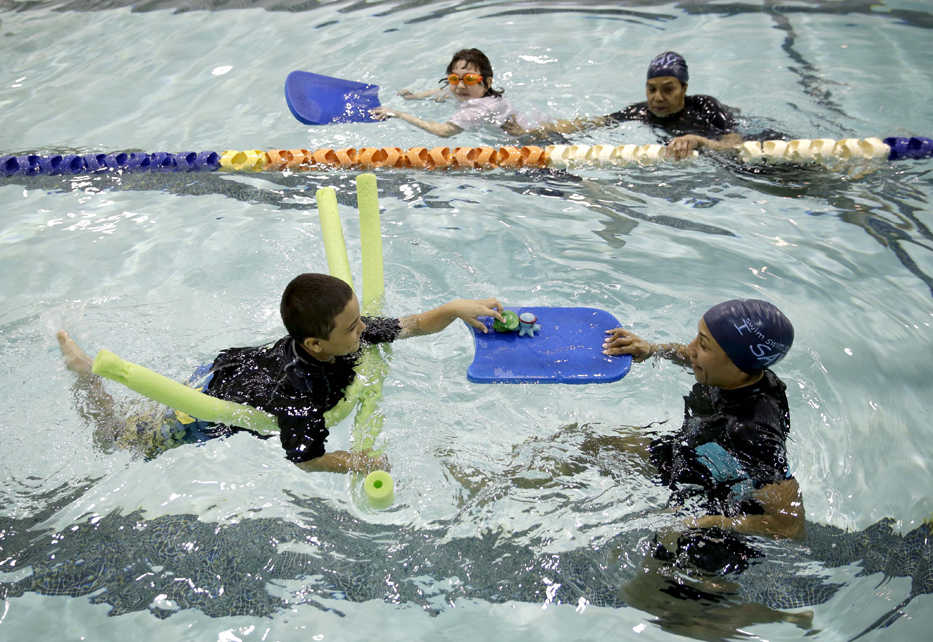NEW YORK — “Ian, Ian, Ian,” squeals 8-year-old Anna as she spots her friend across a pool in the South Bronx. She splashes with excitement until he gingerly joins her in the water.
Five years ago, Anna wouldn’t even utter “Mama.”
Anna and Ian, 7, are on the autism spectrum. Among their challenges is learning how to swim. With 1 in 68 American children falling on the spectrum, many with a penchant for wandering near water, parents and advocates believe swim safety is crucial.
That’s why the nonprofit Autism Speaks began a year ago to help swim programs around the country provide more personal attention, patience and specialized techniques often required for kids with special needs like those of Anna and Ian.
Among the recipients of $275,000 in grants issued the first year is Agnes Davis, president of swim, swim, swim I SAY. She’s a kindly kid whisperer in a swim cap who makes special cupcakes for her charges as she gently encourages them to master lifesaving skills.
“Agnes is a godsend,” said Anna’s dad, Maurice Shalah of Manhattan. “We tried so many different programs since she was about 2 years old and she never learned to swim until we came here. This program, after two sessions, she was swimming.”
Among Anna’s delays is speech apraxia, he said as he watched her in the pool during a recent lesson on the campus of Hostos Community College. “This requires less of her to talk than other activities and she can just enjoy. She swallows half the pool because she’s so happy.”
Davis’ program is one of 65 to receive Autism Speaks funding for families with financial need. She has about six other instructors, including her older sister, Neiza, who taught her to swim as a girl.
“We’re going to do our big circles, OK? OK? Let’s do our big circles,” Davis urges one young recipient, providing plenty of repetition and offering instructions in small chunks. “Are you an octopus today? You have to move your arms if you’re an octopus. Biiiig circles.”
Davis knew little about autism when a mother of a child on the spectrum approached her back in 2012.
“She couldn’t find a place where she felt her child was either, A, accepted or comfortable,” Davis said.
“They couldn’t get the child to fit in. There wasn’t anyone that was patient enough to work with the child. I said to her, ‘You know what, it’s a kid. Just bring him and we’ll see what happens.’ That’s three years ago and she’s still with me,” Davis said.
Vanessa Andronico, the Bronx mother of 8-year-old twins Jayson and Juston, found Davis last August through Autism Speaks. Both boys are on the spectrum.
“We live very close to water. I was concerned about my children’s safety,” she said. “They were nervous the first time we came so they brought the water to them in a bucket. One of my sons put his feet in, and inch by inch they went in the pool.”
Singing in the pool had to be abandoned, Andronico said.
“My sons just don’t like singing. They’ve never liked it and they were singing ‘Twinkle, Twinkle’ when floating. It didn’t work,” she said.
Now, both look forward to Saturday morning swim class after breakfast each week.
“Jayson’s favorite part is that he gets to swim up to 12 feet. Juston likes to dive,” Andronico said. “It’s a blessing to find the right staff that want to continue teaching them.”
Positive reinforcement — and at just the right time — is key, Davis said.
“It can’t always be about what you the instructor wants to accomplish,” she explained.
Sometimes, one full lap of back stroke is a major accomplishment, as in the case of Jayson.
“It’s definitely confidence-building for them, getting them to know they can do certain things,” said Guy Deangelis, the twins’ dad as he offered a high-five poolside. “The competition sports didn’t work out too good for them. This isn’t a competition.”
So far, about 1,400 kids have received financial assistance for swim lessons through Autism Speaks.
Special incentives come in handy, including Davis’ special cupcakes topped with blue icing the color of pool water.
“If you beat me you can have two cupcakes,” she challenges another of her students. “Let’s go. I’m winning! Come on, kick. Good. Yes!”
Lisa Goring, executive vice president of programs and services for Autism Speaks, helps oversee the grants.
“We know that approximately 50 percent of children with autism wander and they tend to gravitate toward water. Unfortunately when a death is involved it’s very often a death by drowning, when they are wandering,” she said.
Since starting the swim grants, Autism Speaks has heard from parents and instructors alike, including this one of a 3-year-old in Atlanta who voiced this common fear: the boy’s attraction to water combined with no sense of danger.
“Christopher only uses three words on a consistent basis,” the parent wrote. “To hear him repeat ‘kick’ after the instructor and then to see him actually then begin to kick brought tears to my eyes — and to hers!”
Follow Leanne Italie on Twitter at http://twitter.com/litalie

